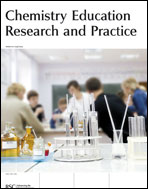A HISTORICAL APPROACH TO THE DEVELOPMENT OF CHEMICAL EQUILIBRIUM THROUGH THE EVOLUTION OF THE AFFINITY CONCEPT: SOME EDUCATIONAL SUGGESTIONS
Abstract
Three basic ideas should be considered when teaching and learning chemical equilibrium: incomplete reaction, reversibility and dynamics. In this study, we concentrate on how these three ideas have eventually defined the chemical equilibrium concept. To this end, we analyse the contexts of scientific inquiry that have allowed the growth of chemical equilibrium from the first ideas of chemical affinity. At the beginning of the 18th century, chemists began the construction of different affinity tables, based on the concept of elective affinities. Berthollet reworked this idea, considering that the amount of the substances involved in a reaction was a key factor accounting for the chemical forces. Guldberg and Waage attempted to measure those forces, formulating the first affinity mathematical equations. Finally, the first ideas providing a molecular interpretation of the macroscopic properties of equilibrium reactions were presented. The historical approach of the first key ideas may serve as a basis for an appropriate sequencing of the teaching and learning of chemical equilibrium. Finally, the paper aims also to encourage teachers to introduce historical and philosophical issues in their chemistry classrooms. [Chem. Educ. Res. Pract.: 2004, 5, 69-87]

 Please wait while we load your content...
Please wait while we load your content...